Production Piece
Project Download: https://nathan1230.itch.io/vr-art-gallery
Introduction
My project is an Optical Illusion Art Gallery, which showcases a range of optical illusions that deceive the users perception of certain images or their sense. The purpose of my project was to understand if optical illusions work the same in Virtual Reality as they do in real life.
I believe my project relates to each of the module objectives. Firstly, by researching ideas to develop a project related to emerging technologies. I have researched many different types of illusions and incorporated them into a walk able experience.
Secondly, I believe I have demonstrated effective project management skills. Not only did I create a Gantt chart, but I created a To-Do List which specified what features, assets and issues I had to complete.
Thirdly, I believe I was able to employ my software proficiency by making use of the features of Unreal Engine and solving any issues that arose. As there were some major problems throughout the development.
Additionally, by incorporating ethical values and principles. By implementing features and physical aids for people with any physical disabilities. As I intend to make my project accessible for anyone.
Finally, by showing my forward-thinking skills by integrating emerging technology trends and concepts. I believe I showed these skills by incorporating ethical considerations into my project and thinking about the future of accessibility for all types of people.
Idea Generation and Research
I researched a wide range of illusions, and gathered the ones I thought would be most appropriate and include a range of effects they give off. Some of the illusions were also from previous personal experiences, such as the Vortex Tunnel, Ames Room and Infinity Mirrors. As I knew what effect they had on the user, I hoped to see if their effect was the same in Virtual Reality. With this research, I was able to create an optical illusion art gallery, with the hope of creating the illusions intended effects.
I had researched what an art gallery consists of, and more specifically what information is present under a piece of work. I intended to include information next to each illusion such as:
- Name of Illusion
- Creator/Source
- Year of Creation
- Tips (Tells the user what to do to see the illusions effect)
These pieces of information make the experience seem more like an art gallery and add a small detail to the level. Additionally, the layout of an art gallery. I had found that art galleries typically consist of path the user can follow. However, the path in my project is more forced upon the user, instead of giving them their own freedom. As I intended for the user to only see one illusions at a time.
Project Management
Approach and Employed Strategies
In order to assist me with the project management, I had created two documents. These were a Gantt Chart and a Google Drive Document which acted as a To-Do List.
My Gantt Chart included the major milestones, which I knew would be a part of my project from the beginning. Such as the Level Blockout, Illusion Incorporation and Playtesting. I was able to effectively plan the dates for each milestone and was confident in my ability to do so. As creating projects in Unreal Engine is a strength of mine, and it is the game engine I am most comfortable with. I felt that I could easily stick to my schedule and solve any issues that arose.

The To-Do List broke down the milestones of my Gantt Chart, and I was able to focus on each task individually, which made creating the project easier. The To-Do List was a greater assistance then the Gantt chart. Because the list allows me to break the project down into smaller steps. I also implemented a colour-coding system into the list, to understand what stage each objective was at. For example, unhighlighted text were yet to be created. Orange highlighted text meant I had created the prototype versions and had to playtest their functionality. Green highlighted text meant they have been playtested and work as intended. I felt this to be an enormous visual aid and helped speed up the creation of the project. As I believe having a list which is not colour-coded causes unnecessary stress and anxiety, as sometimes I cannot decide where to start with some tasks.

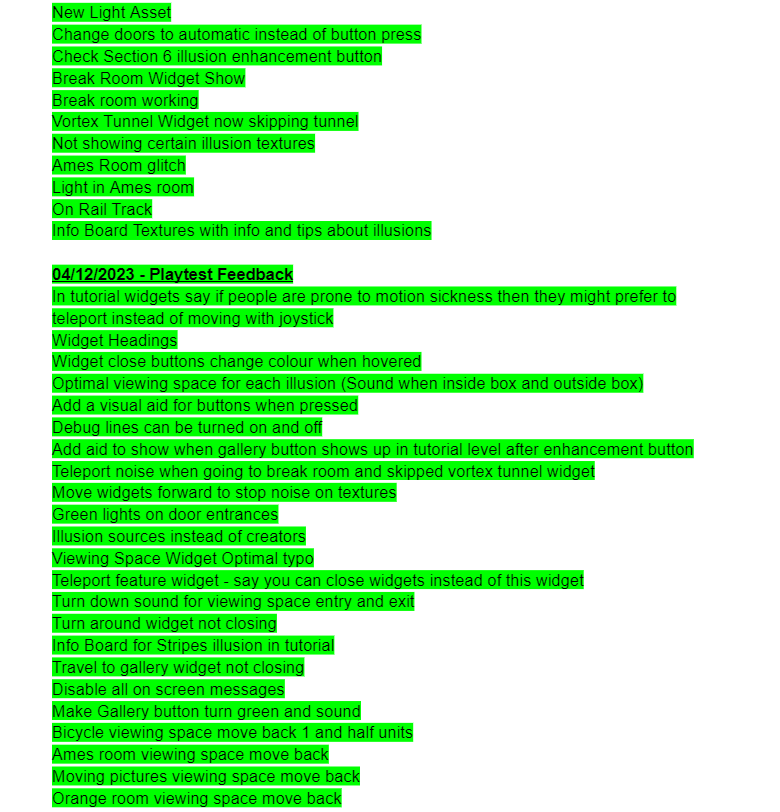
Challenges Faced
By far the biggest challenge I faced was attempting to create this project within Unreal Engine. Before this challenge I had already started to create the level in Unreal Engine 5.2.1. However, as time passed I understood that I would have to downgrade my project to a previous version of Unreal Engine. As a lecturer and I had difficulties trying to create the project in this version.
We could not successfully package a Virtual Reality project within Unreal Engine 5.2.1. We did some research and found that it would be easier to use a previous version of Unreal Engine, as these versions support the Meta Quest 2, which is the headset I was using. We eventually tried packaging the project in 5.0.3, and after many different packaging attempts the project was successfully packaged and playable. The issue was that we needed to download the certain Software Development Kit, Java Development Kit and Native Development Kit.
Additionally, I also had to download the Oculus Application, Android Studio and the Meta Quest Developer Hub. These were needed in order to allow the Virtual Reality headset to link to my laptop. Furthermore, in order to playtest my project, I had to package the project each time, which took on average two minutes. I did find a solution to this which also came with its own problem. This solution required me to have the Quest Link activated on the headset whilst being in Unreal Engine. However, I was only able to play the game once before it crashed.
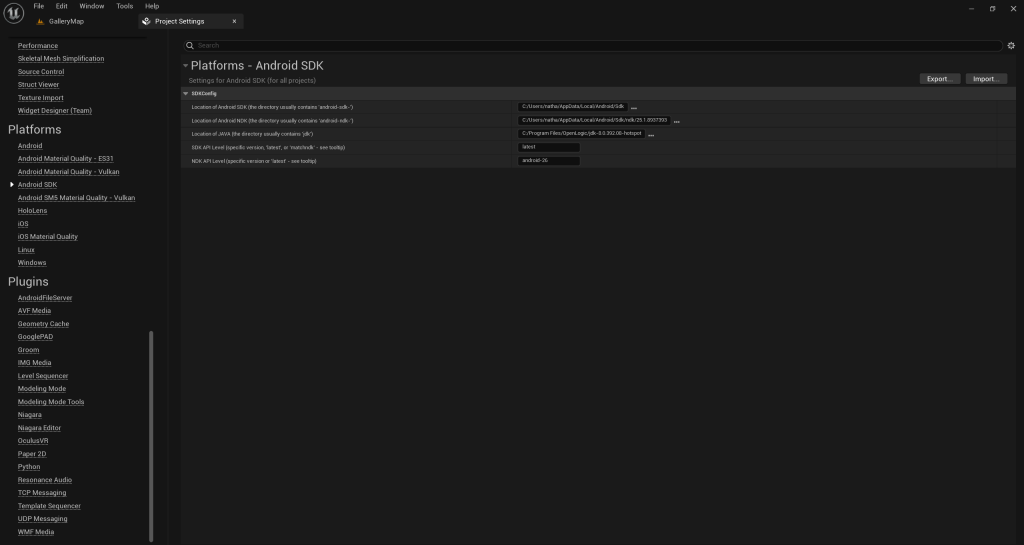
Software Proficiency
Level Streaming
I found that playing the project through the Virtual Reality headset had some performance issues. Mainly causing a slow and lagging experience. My solution was to use the Level Streaming feature within Unreal Engine. This feature helps performance by loading or unloading certain sections by toggling their visibility and easing the performance on the hardware. I knew this was necessary as the Meta Quest 2 headset is not as powerful as a desktop or laptop and would need assistance in order to create a smooth experience. The Level Streaming feature was created by adding Level Streaming Volumes within the level, and placing them around the sections I would want to be unloaded or loaded in.

On-Rail Track
I had created an accessibility feature for the user, by creating an On-Rail Track for the Vortex Tunnel. This allows the user to experience the Vortex Tunnel if they cannot physically walk through it, or if they want to experience it in another way than usual. I had to consider how long it would take the user to move through, as they could still be prone to photosensitive epilepsy, but also experience the illusion for a sensible amount of time.
The blueprint below starts the track after the button has been pressed and sets the player’s location overtime with a Timeline node. During this, the player cannot move or teleport. However, they are free to look around. Once the track has reached the end the player has the freedom to move once again.
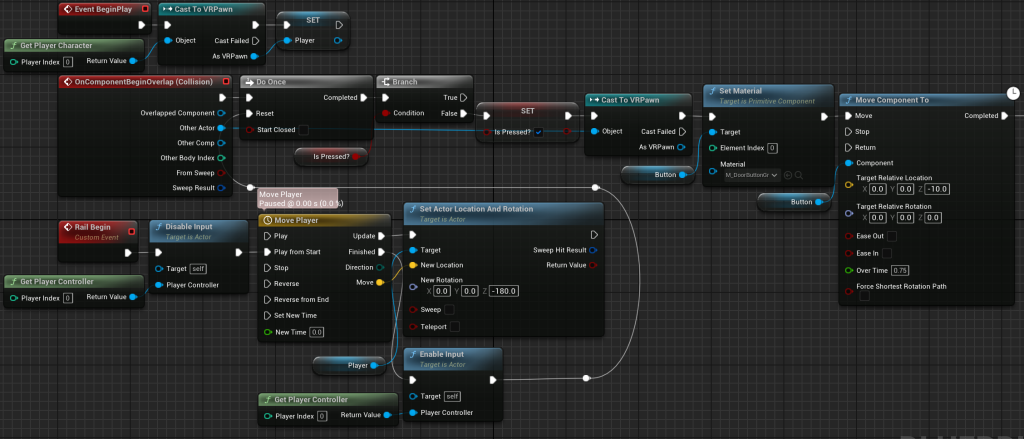
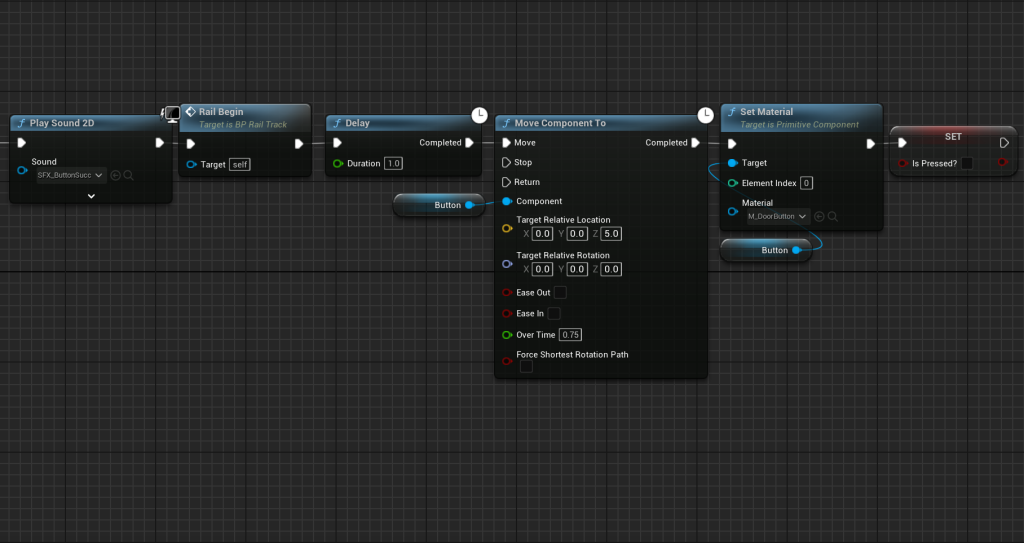
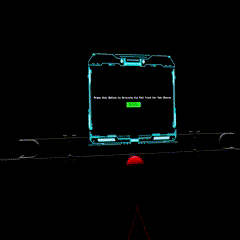
Break Room Ability
Another feature I had created with ethical considerations in mind was the Break Room Ability. This ability would teleport the user to a safe space whilst experiencing the Vortex Tunnel. The feature instantly teleports the user back to the break room, and then offers them the ability to either go through the tunnel again or skip it entirely. I had configured this ability to a simple press of the A button, as I did not want this to be complex in case a user needs it instantly.
The blueprint checks whether the player has pressed the A button. However, in order to teleport the player must be inside the Break Room Box, which is placed around the vicinity of the Vortex Tunnel. As I did not want the player to be able to teleport from anywhere in the level, as this would break the whole experience.

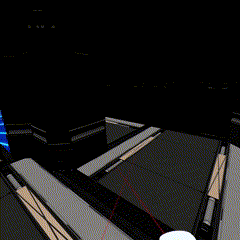
Joystick Movement
One feature I was sceptical about implementing was being able to move around with the Joystick. The reason being is that it can cause motion sickness and feelings of nausea. As I have felt these feelings with previous experiences. However, in my project I found that these nauseous feelings were not present, due to the frame rate and smooth movement. Additionally, I was glad I implemented this feature, as using the teleport feature over and over again was becoming tedious.
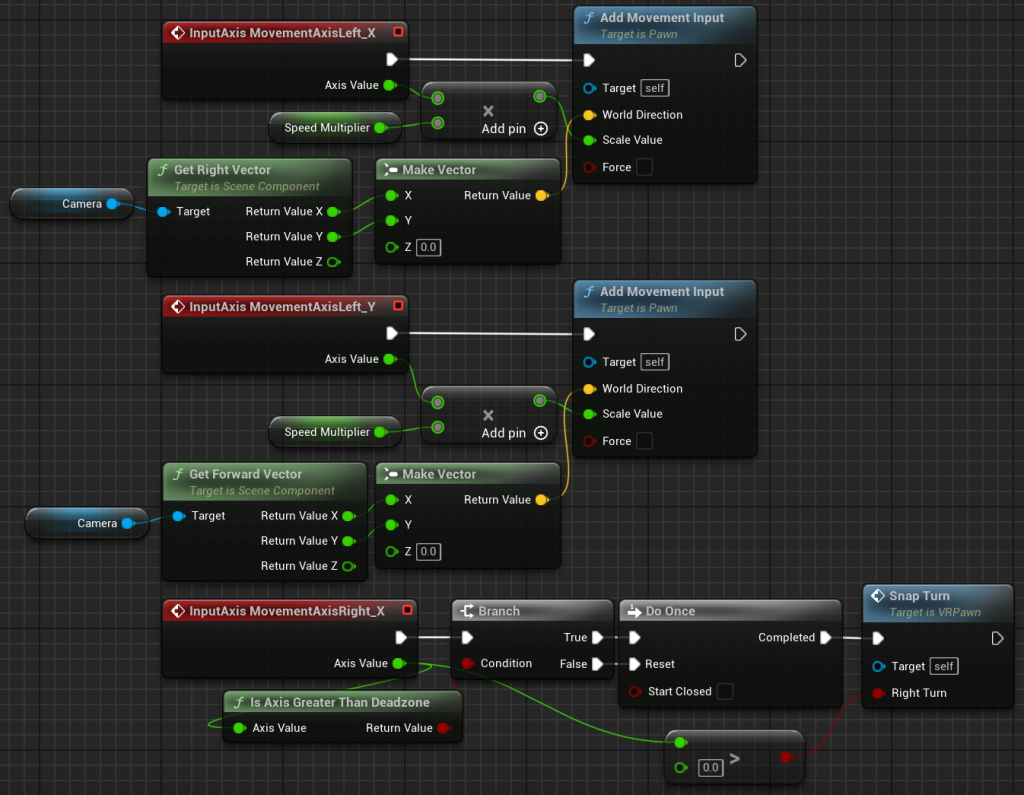
Optimal Viewing Spaces
From the feedback I received I was informed that users were unsure of how far away they would have to be from illusions in order for their full effect to take place. This led me to the creation of the Optimal Viewing Spaces, which would signal to the user if they were in the correct space to see the illusion. These signals are audio and visual aids to inform the player when they are in the viewing space.
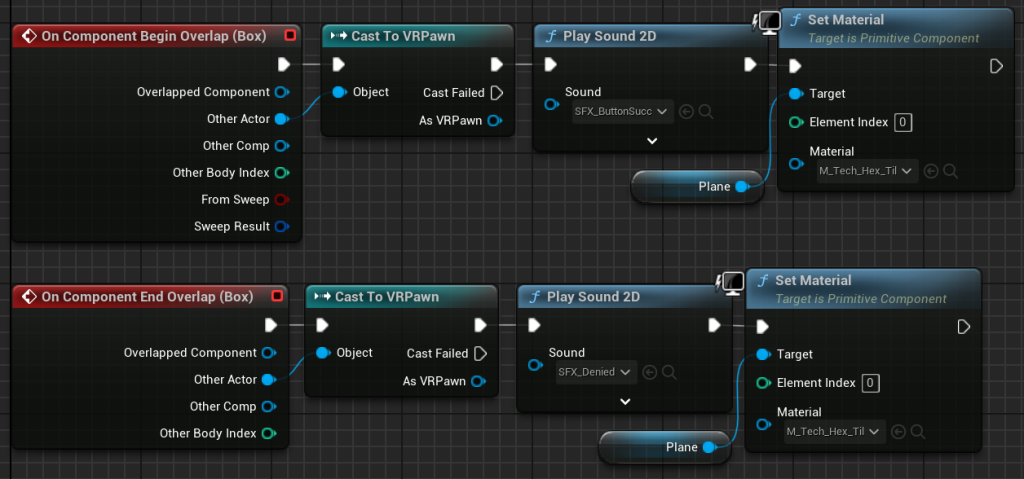
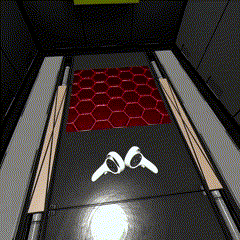
Debug Lines
Since there are interactable widgets, it would be sensible to allow the player to see where they are aiming, as I found it was difficult without the visual aid of the Debug Lines. However, I found that having these lines constantly visible was annoying, as sometimes they were distracting and irritating. The solution was to be able to toggle their visibility. This was possible by pressing the B button.
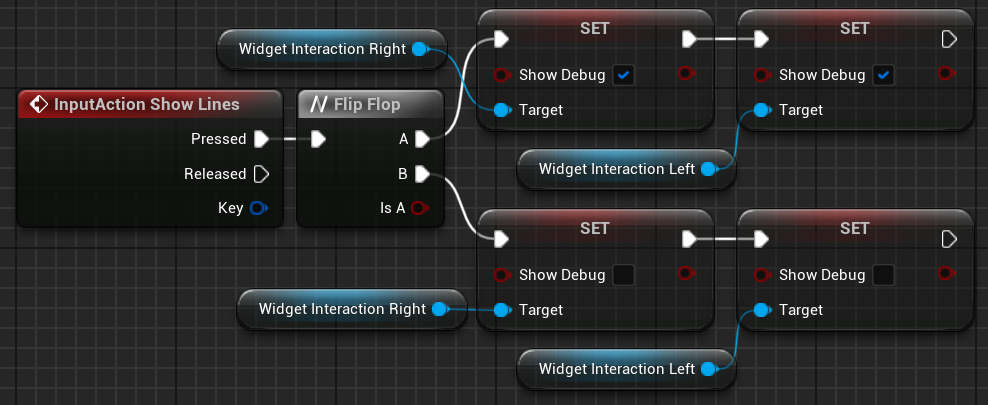
Door Collision Issue
I faced an issue where I could not teleport through the door when it was open. I debugged this issue by changing the View Mode in the engine to “Player Collision”. I was able to see the issue, as there was still collision in the middle of the asset. I opened the static mesh and found the collision settings, and simply changed the “Collision Complexity” to “Use Complex Collision As Simple” instead of “Project Default”. I was then able to successfully teleport through the door when it was open.

Ethics and Values
Many ethical considerations were considered to be part of my project. I set out to create an experience anyone could take part in and reduce any uncomfortable feelings and make the user feel safe. I understood the design principles of a user experience, and also created accessibility features alongside audio and visual aids.
Accessibility Features
The On-Rail Track was created for people with physical disabilities, as I wanted everyone to have the chance to experience the Vortex Tunnel.
I created the Break Room to coincide with the Vortex Tunnel, as I had to make sure that anyone who was in the tunnel could escape quickly, if any sudden epileptic seizures occurred.
Audio and Visual Aids
I felt that including audio and visual aids would help the user as a confirmation of something they have done or guiding them. For example, when pressed, the buttons will turn green for a short period of time, and the user would know their action was confirmed.
When the Close button on the widgets is hovered, there is a subtle sound to indicate this. When the widgets are closed there is another confirmation sound to tell the user this action has been confirmed.
Each time the user teleports there is a confirmation sound that alerts the player of their completed teleport action. This sound also plays when the user teleports to the Break Room.
Green lights were placed above doors to guide the player through the level. I received feedback and sometimes users became lost in the level. This use of colour theory and lighting made it easier for users to gain their sense of direction and traverse the level.
Considerations
There is one instance of a trigger warning which shows before the Vortex Tunnel. It warns anyone who is prone to photosensitive epilepsy to not experience the tunnel, and they are able to skip it.
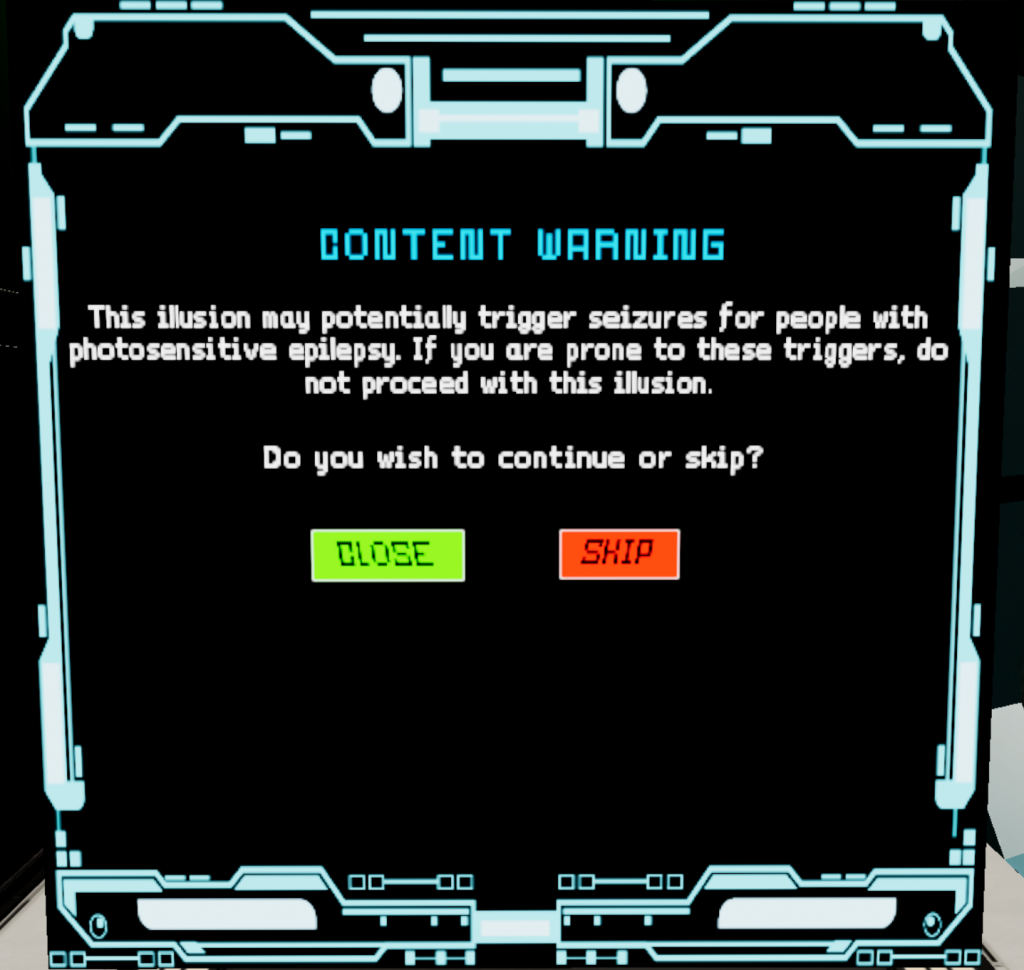
After 15 minutes of gameplay a widget will appear in front of the player, suggesting they should take a break. This period of time is suggested by the Department for Business, Energy & Industrial Strategy (2020). It was sensible to implement this widget, as I do not intend to have users strain their eyes in this experience.
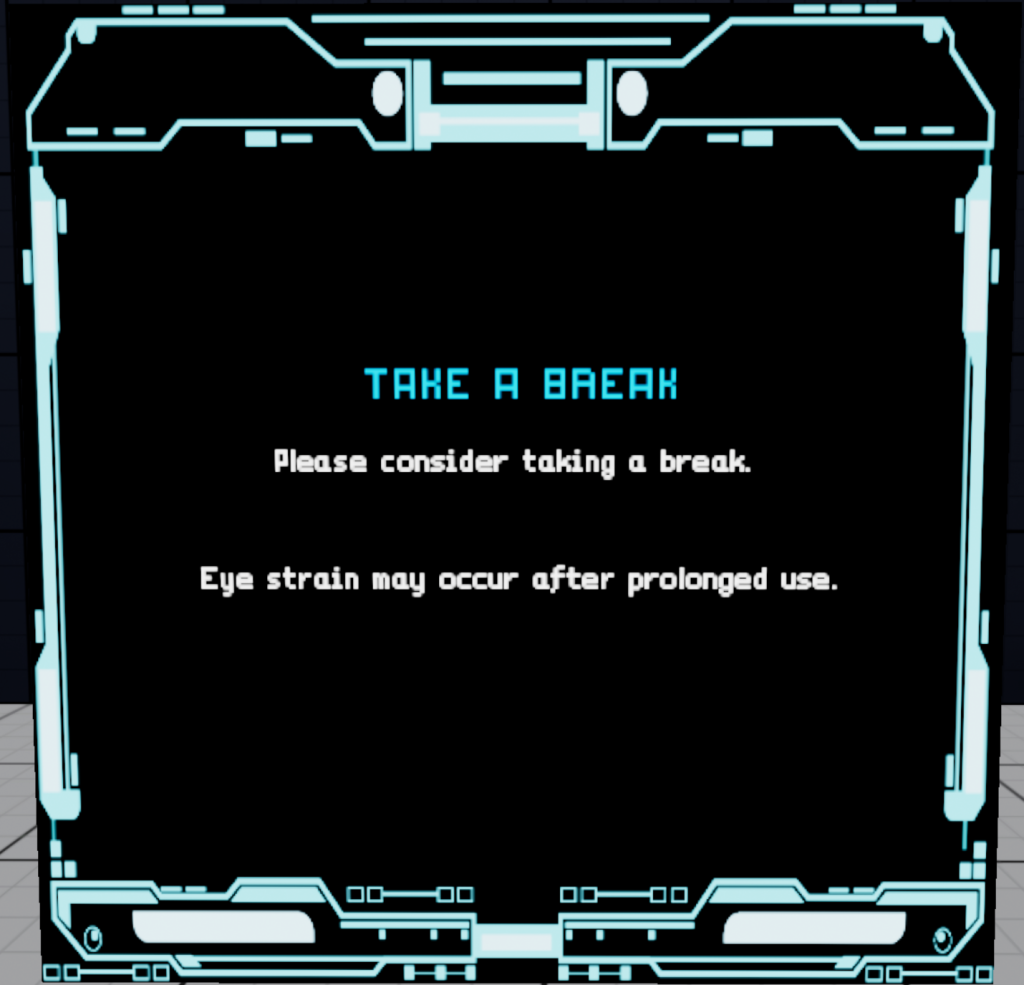
Some of the widgets give specific instructions to the player. Such as the controls of the experience, how to press buttons and how to travel to the gallery experience level. If these widgets were not present then the user may have difficulty figuring out how to complete all of these actions.

I tested the joystick movement and found that it did not cause any motion sickness. This was a major feature, as teleporting can become tedious when overused, and it quickens the movement of the user, and this is what I intended for the experience.
Widgets were placed at a comfortable distance at the start of the experience. I aimed for them to be clearly visible, but not far enough away so the user could not read them.
The text size on the widgets had to be suitable for the user to easily read. I had found that larger text sizes did not fit onto the widgets themselves and experimented with the sizes until I found one that fit.
Each illusion and widget are placed at a reasonable height, in order to not strain the users neck. This relates to creating a comfortable experience, and not causing the user any harm.
Originally I wanted the Ames Room to offer a small viewport, as I did not want the user to be able to explore this room. However, with this design I came across a glitch where the user would fall through the map when they were too close to the window. This led me to change the design of this section and offer a wider view, whilst also finding a solution to the glitch.
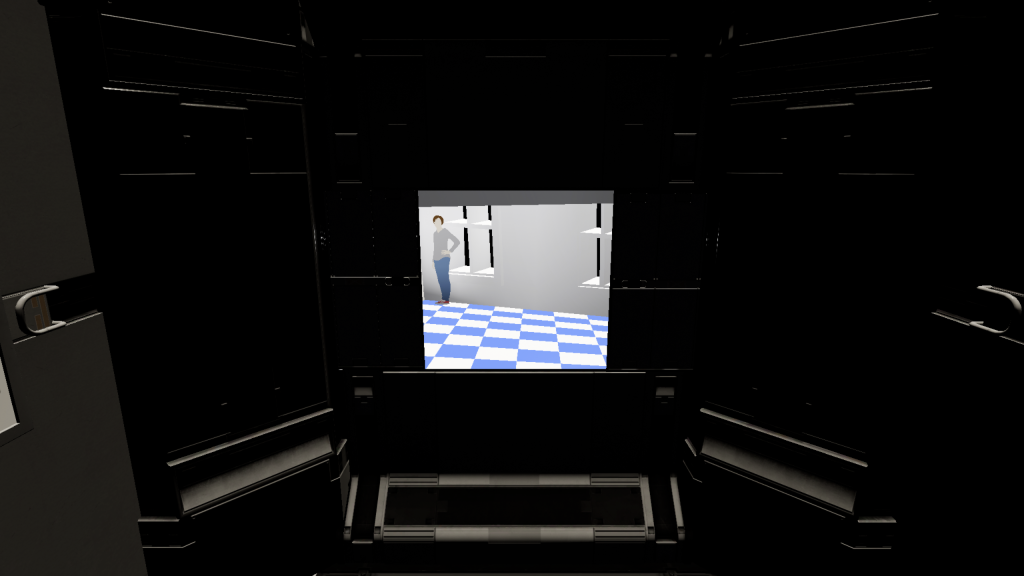
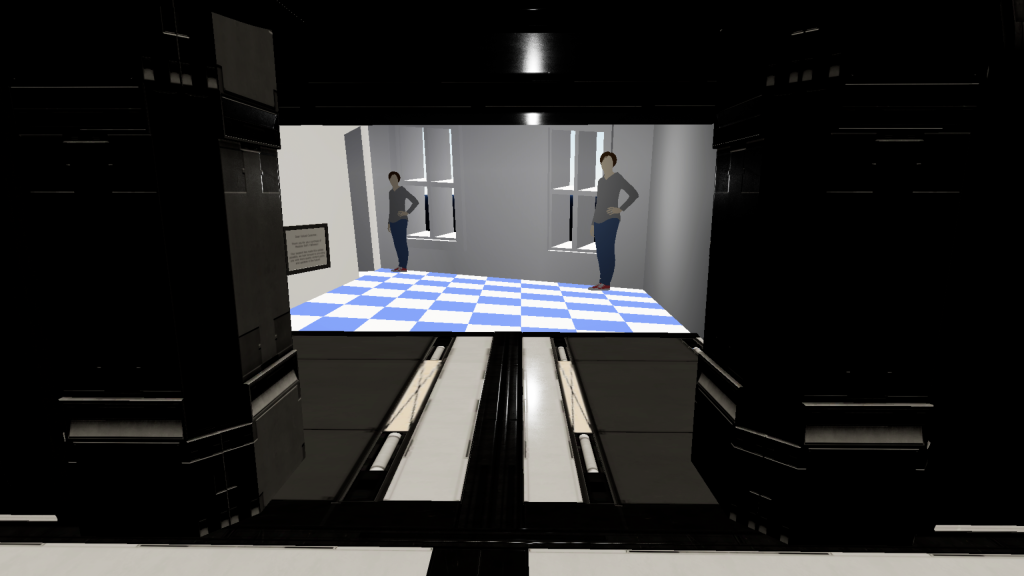
Design Principles
Gestalt Design Principles were included within my experience by making the Close button of the widgets stand out. By making the button green, and contrasting against the dark background, the user could easily see the button. Additionally, by having buttons contrast to the environment with their size, shape and colour.
Forward-Thinking and Emerging Trends
I believe my project demonstrates forward-thinking by assisting the user and their considerations. I did not want to limit who could play the experience, as I took considerations for people with physical disabilities and people who are prone to seizures from flashing images.
I believe this to be a trend as PlayStation recently unveiled a new controller for disabled people (Gerken, 2023). As I believe consideration for everyone who plays games is important, and no one should be left out. Furthermore, as technology advances I think there will be more accessible features for disabled people. Not only with the standard form of gaming, but in Virtual Reality too.
References
Department for Business, Energy & Industrial Strategy (2020) The safety of domestic virtual reality systems (4527). Available online: https://assets.publishing.service.gov.uk/media/5f763502d3bf7f7c2bcf9eb9/safety-domestic-vr-systems.pdf [Accessed 14/12/2023].
Gerken, T. (2023) Sony debuts first PS5 controller for disabled gamers. Available online: https://www.bbc.co.uk/news/technology-67635851 [Accessed 14/12/2023].
3D Models
dogagulhan (2018) Ames Room v0 [3D Asset]. Available online: https://sketchfab.com/3d-models/ames-room-v0-b164d3b2ef2d446da945878399b2e118 [Accessed 20/11/2023].
Dumokan Art (2020) Concrete Tunnel Sections [3D Asset]. Available online: https://sketchfab.com/3d-models/concrete-tunnel-sections-1c3ba52c66d04101b58bfb32170e62be [Accessed 22/11/2023].
ExtraSo (2023) Coffe Table [3D Asset]. Available online: https://sketchfab.com/3d-models/coffe-table-f8cd439ada2a48e68c5e64c45fb67440 [Accessed 20/11/2023].
inuhitman (2017) SciFi Light 15 [3D Asset]. Available online: https://sketchfab.com/3d-models/scifi-light-15-f4042c38c5c44aafb6058fc772d15937 [Accessed 4/12/2023].
Jonathon Frederick (2017) Modular SciFi Season 1 Starter Bundle [3D Asset]. Available online: https://www.unrealengine.com/marketplace/en-US/product/modular-scifi-season-1-starter-bundle [Accessed 20/11/2023].
Ramil Kudashev (2017) Sci-Fi Door [Spaceship Indweller] [3D Asset]. Available online: https://sketchfab.com/3d-models/sci-fi-door-spaceship-indweller-0bf94076c8c441aca241d716ce41f9d7 [Accessed 20/11/2023].
The Lost Sock (2023) Button Round Flat [3D Asset]. Available online: https://sketchfab.com/3d-models/button-round-flat-c7e7966f8a7c49b8a7bae8974d08e120 [Accessed 20/11/2023].
Font
Sal (2006) Technicality [Font]. Available online: https://www.dafont.com/technicality.font [Accessed 27/11/2023].
Images
Akiyoshi Kitaoka (n.d.) Bicycle [Image]. Available online: http://brainden.com/eye-illusions.htm [Accessed 20/11/2023].
Akiyoshi Kitaoka (2003) Rotating snakes [Image]. Available online: http://www.psy.ritsumei.ac.jp/~akitaoka/index-e.html [Accessed 20/11/2023].
Akiyoshi Kitaoka (2004) Rollers [Image]. Available online: http://www.psy.ritsumei.ac.jp/~akitaoka/index-e.html [Accessed 20/11/2023].
Akiyoshi Kitaoka (2020) Black Hole [Image]. Available online: http://www.psy.ritsumei.ac.jp/~akitaoka/saishin62e.html [Accessed 20/11/2023].
Akiyoshi Kitaoka (2020) Moving pictures [Image]. Available online: https://www.creativebloq.com/features/optical-illusions [Accessed 20/11/2023].
Baingio Pinna (2000) Move Your Head [Image]. Available online: https://www.sciencedirect.com/science/article/pii/S0042698900000729 [Accessed 20/11/2023].
Beau Deeley (2012) Spinning Vortex Illusion Pattern [Image]. Available online: https://www.moillusions.com/spinning-vortex-illusion-pattern/ [Accessed 20/11/2023].
BrainDen.com (n.d.) Amazing Maze [Image]. Available online: http://brainden.com/eye-illusions.htm [Accessed 20/11/2023].
Creative Bloq (2023) Van Gogh Starry Night optical illusion [Image]. Available online: https://www.creativebloq.com/features/optical-illusions [Accessed 22/11/2023].
Dr Michelle Dickinson (2019) You can only see this optical illusion if you shake your head (I’m serious) [Twitter]. 10 January. Available online: https://twitter.com/medickinson/status/1083203930740293632?lang=en [Accessed 20/11/2023].
hoanglong903 (2020) Border Frame Youtube Twitch Eyes Pearl [PNG]. Available online: https://pngtree.com/freepng/border-frame-youtube-twitch-eyes-pearl_5653861.html [Accessed 27/11/2023].
Jace (2015) INSANE OPTICAL ILLUSION [Video]. Available online: https://www.youtube.com/watch?v=Z0aLjw52ip4&t=15s [Accessed 27/11/2023].
lightenergystudio.com (n.d.) Infinity Mirror Displays and Infinity Mirror Tables [PNG]. Available online: https://www.pinterest.co.uk/pin/316800155053633078/ [Accessed 4/12/2023].
patpongstock (n.d.) Loop tunnel wormhole. warp in science fiction hole vortex hyperspace tunnel.3d render [JPG]. Available online: https://www.freepik.com/premium-photo/loop-tunnel-wormhole-warp-science-fiction-hole-vortex-hyperspace-tunnel-3d-render_4686415.htm [Accessed 27/11/2023].
Sounds
DExUS5 (2016) teleport.wav [SFX]. Available online: https://freesound.org/people/DExUS5/sounds/361686/ [Accessed 22/11/2023].
Fachii (2016) Button hover.wav [SFX]. Available online: https://freesound.org/people/Fachii/sounds/338229/ [Accessed 22/11/2023].
JustInvoke (2018) Success Jingle [SFX]. Available online: https://freesound.org/people/JustInvoke/sounds/446111/ [Accessed 22/11/2023].
MATRIXXX_ (2020) Select, Granted 06.wav [SFX]. Available online: https://freesound.org/people/MATRIXXX_/sounds/523763/ [Accessed 22/11/2023].
onderwish (2019) Sci-Fi Survival Dreamscape [SFX]. Available online: https://freesound.org/people/onderwish/sounds/468407/ [Accessed 22/11/2023].
Raining-0n-Satrn (2022) Pulsating Hum [SFX]. Available online: https://freesound.org/people/Raining-0n-Satrn/sounds/652555/ [Accessed 22/11/2023].
Sergenious (2008) dooropen1.wav [SFX]. Available online: https://freesound.org/people/Sergenious/sounds/55826/ [Accessed 22/11/2023].
Sergenious (2008) dooropen2.wav [SFX]. Available online: https://freesound.org/people/Sergenious/sounds/55827/ [Accessed 22/11/2023].
suntemple (2014) Access Denied [SFX]. Available online: https://freesound.org/people/suntemple/sounds/249300/ [Accessed 22/11/2023].
Leave a Reply